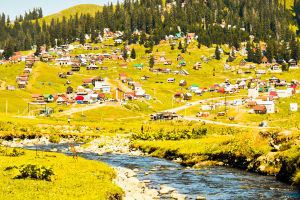Have you ever felt the pull of a place that seems to whisper stories from ancient times?
Imagine standing at the base of a giant snow-capped mountain, known for centuries as where an ancient vessel from legend came to rest.
That's Mount Ararat—the highest peak in this region, straddling myth, history, and adrenaline-fueled adventure. Whether you're drawn by the epic tale or the thrill of scaling a 5,137-meter summit, Ararat offers an experience that stays with you long after you descend.
Mount Ararat
The Legend of an Ancient Vessel
Mount Ararat's fame largely comes from its place in ancient folklore. According to ancient legends, a great vessel was believed to have come to rest on 'the mountains of Ararat. Over time, travelers, explorers, and treasure hunters have claimed to have found wood fragments or boat remains high on its slopes—but none have been verified scientifically. Still, this legend inspires a sense of awe and wonder that's hard to shake.
Locals in the Ağrı province often share stories of mysterious wooden structures spotted in hidden crevasses. While archaeology hasn't confirmed anything yet, the legend sparks imagination and mystery.
Planning Your Climb: Logistics & Permits
Mount Ararat is located near the border, accessible from the town of Doğubeyazıt. Climbing Ararat requires official permission from Turkey's Ministry of Culture and Tourism, and a government-approved guide is mandatory.
Steps to Prepare:
1. Book a package tour (typically 4–7 days): Includes campsite support, meals, porters, guides, and permit. Prices range between US$700–1,200 per person, depending on group size and season.
2. Climbing season: Mid-June to early September offers the safest window—weather is more stable, and snow risk is reduced.
3. Permitting: Your guide handles the paperwork. Around US$100–150 is included in the package, covering both the permit and insurance.
The Standard Route: South Ridge
The most common path up Mount Ararat is the South Ridge, featuring several key stages:
1. Ascent basecamp (3,200 m): Settle in tents, acclimate with rest and light hikes, drink water to prepare.
2. High camp (4,300 m): A cold, windy spot with basic toilet facilities. You sleep early to prepare for the summit push.
3. Summit push (approx. 10–12 hours round-trip): Usually starting around 2 AM to reach the peak by sunrise—packed with stakes and fixed ropes but still a physically demanding climb.
Essential gear: Insulated clothing, mountaineering boots, crampons, ice axe, headlamp, down jacket, and sun protection. Guides also provide ice axes, helmets, and ropes.
What to Expect on the Mountain
1. Physical challenge: Altitude and remoteness mean every step counts. You'll feel wind, cold, and thin air—but with proper pacing and hydration, most climbers make it.
2. Mental endurance: Long hours of steady uphill, darkness and cold, and unsteady footing test your determination. Climbers often speak of profound personal insight amidst these conditions.
3. Rewarding summit: On clear days, the view stretches across eastern Turkey, and the Armenian highlands—absolutely breathtaking.
Where to Stay Before and After
Since Doğubeyazıt is your base, these are solid local options:
• Hotel Ishak Pasha Palace: Named after a nearby Ottoman-era castle, it's mid-range with clean rooms and hearty breakfast—around US$60–80/night.
• Efe Motel: Budget-friendly at US$30–40/night, friendly and near tour offices.
• Cappadocia-style Guesthouses (DIY acclimatization): For lighter mountaineers aiming to acclimatize over multiple days.
Exploring Beyond the Climb
Even if you don't summit, Ararat's surroundings offer plenty to discover:
1. Ishak Pasha Palace: A 17th-century gem blending Ottoman and Persian architecture—entrance around US$5.
2. Local hot springs in Doğubeyazıt: Relax aching muscles post-climb—day passes around US$10.
3. Village homestays: Gain insight into Kurdish-Azerbaijani culture, with homemade meals and warm hospitality.
Safety & Expert Advice
Turkey's Directorate of Mountaineering and Trekking recommends climbers have prior high-altitude trekking experience.
Dr. Selim Orhan, high-altitude trekking specialist, stated, "At elevations over 4,000 meters, climbers face heightened risk of altitude sickness. Acclimatization and hydration are critical for safety."
Guides also monitor weather forecasts daily. Sudden storms or snow can shift summit attempts, so flexibility in your schedule is key.
Tasting Local Flavors
After the intense climb, real Turkish comfort foods await:
• Gözleme: Flatbread with cheese, spinach, or potato fillings — a comforting post-hike snack.
• Tavuk Güveç: Chicken and vegetable stew slow-cooked in a clay pot — US$5–8.
• Ayran: Cool yogurt-based drink to refresh and restore — ~US$1.
Could You Conquer Ararat?
Mount Ararat isn't just another mountain—it's a journey through legend, a test of endurance, and a chance to stand where myth meets reality. With proper preparation, respect for altitude, and a seasoned guide, many climbers—beginners included—reach the summit.
So tell me, does your heart race at the idea of standing atop a snowy peak steeped in history? Would you prefer the challenge of climbing from camp to summit, or more drawn to the idea of exploring local villages and legends at a gentler pace? Either way, Ararat promises something extraordinary.
Ready to start planning? I can help sort out tours, gear lists, or cultural stops—just say the word!


